
A wedding is a ceremony in which two people are united in marriage. Wedding traditions and customs vary greatly between cultures, ethnicities, races, religions, denominations, countries, social classes, and sexual orientations. Most wedding ceremonies involve an exchange of marriage vows by a couple; a presentation of a gift ; and a public proclamation of marriage by an authority figure or celebrant. Special wedding garments are often worn, and the ceremony is sometimes followed by a wedding reception. Music, poetry, prayers, or readings from religious texts or literature are also commonly incorporated into the ceremony, as well as superstitious customs.

A bride is a woman who is about to be married or who is a newlywed.
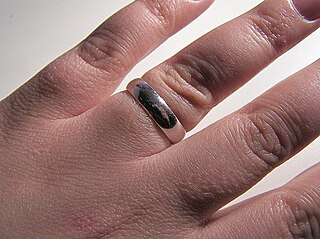
A wedding ring or wedding band is a finger ring that indicates that its wearer is married. It is usually forged from metal, traditionally gold or another precious metal. Rings were used in ancient Rome during marriage.

A wedding cake is the traditional cake served at wedding receptions following dinner. In some parts of England, the wedding cake is served at a wedding breakfast; the 'wedding breakfast' does not mean the meal will be held in the morning, but at a time following the ceremony on the same day. In modern Western culture, the cake is usually on display and served to guests at the reception. Traditionally, wedding cakes were made to bring good luck to all guests and the couple. Nowadays, however, they are more of a centerpiece to the wedding and are not always even served to the guests. Some cakes are built with only a single edible tier for the bride and groom to share, but this is rare since the cost difference between fake and real tiers is minimal.

A wedding dress or bridal gown is the dress worn by the bride during a wedding ceremony. The color, style and ceremonial importance of the gown can depend on the religion and culture of the wedding participants. Wedding dresses hold a significant place in fashion, symbolizing personal expression, and cultural traditions and societal values. In Western culture, the wedding dress is most commonly white, a fashion made popular by Queen Victoria when she married in 1840. In Eastern cultures, brides often choose red to symbolize auspiciousness. These wedding dresses often represent a blend of heritage and contemporary trends, making them a pivotal aspect of bridal fashion and a reflection of evolving style in society.
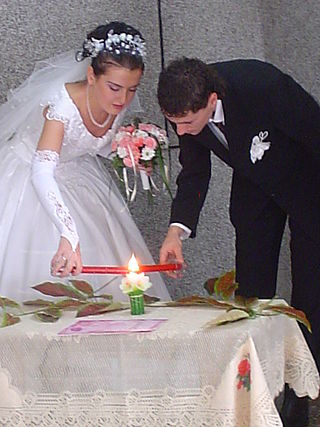
A unity candle is a candle used in a wedding ceremony to symbolize two people joining in marriage.

Bride kidnapping, also known as marriage by abduction or marriage by capture, is a practice in which a man abducts the woman he wishes to marry.
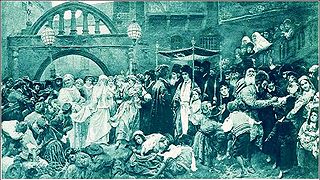
A Jewish wedding is a wedding ceremony that follows Jewish laws and traditions. While wedding ceremonies vary, common features of a Jewish wedding include a ketubah that is signed by two witnesses, a chuppah or huppah, a ring owned by the groom that is given to the bride under the canopy, and the breaking of a glass.
Iranian wedding, also known as Persian wedding, consists of traditions rooted in Zoroastrianism, the primary religion of pre-Islamic Iran. Though the concepts and theories of marriage have been changed by Islamic traditions, the ceremonies have remained more or less the same as they were originally in pre-Islamic Iran. Although modern-day Iran is a multi-ethnic country, Iranian wedding traditions are embraced by the majority of ethnic groups in Iran.

Punjabi wedding traditions are a strong reflection of Punjabi culture with ritual, song, dance, food, and dress that have evolved over centuries.
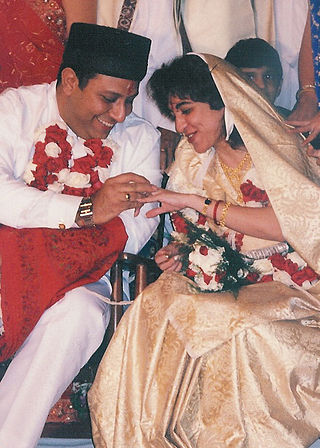
A Zoroastrian wedding is a religious ceremony in Zoroastrianism in which two individuals, a man and a woman, are united. In Zoroastrianism, marriage within the community is encouraged, and is greatly favored in religious texts. The following information will detail ceremony procedures and traditional processes for a Zoroastrian wedding.

Traditional marriage customs in the Philippines and Filipino wedding practices pertain to the characteristics of marriage and wedding traditions established and adhered by them Filipino men and women in the Philippines after a period of adoption courtship and engagement. These traditions extend to other countries around the world where Filipino communities exist. Kasalan is the Filipino word for "wedding", while its root word – kasal – means "marriage". The present-day character of marriages and weddings in the Philippines were primarily influenced by the permutation of Christian, both Catholic and Protestant, Hindu, Islam, Chinese, Spanish, and American models.

The traditional wedding cord, also known as the "wedding lasso", is a piece of paraphernalia used in some Catholic wedding ceremonies. It is actually a representation of a loop of rosary beads made out of white satin or silk. During the wedding proper, this is traditionally formed into a figure-of-eight shape, and then placed around the neck areas of the bride and the groom after they have made their wedding vows, and are already kneeling on pillows for the pronouncement of a wedding prayer. This cord symbolizes lifetime unity or the everlasting union of the bride and groom when they officially become husband and wife, as well as a symbol of marital protection; while the loops formed signifies their love for one another. After the wedding, this marital twine is typically kept by the bride as a wedding souvenir. Use of the traditional wedding cord for weddings is common in Hispanic countries such as Mexico, the Philippines, and Spain.

A page boy is a young male attendant at a wedding or a cotillion. This type of wedding attendant is less common than it used to be, but it is still a way of including young relatives or the children of friends in a wedding. Pages are often seen at British royal weddings, such as the wedding of Prince William and Catherine Middleton in 2011. At cotillions, there may be many pages, for effect.

Binukot, also spelled Binokot, is a pre-colonial Visayan tradition from the Philippines that secludes a young woman with the expectation that seclusion will result in a higher value placed on the girl by marital suitors in the future. It originally applied to young noblewomen. The name literally means "wrapped up" or "veiled" in Visayan languages, in the sense of seclusion.

Bride price, bride-dowry, bride-wealth, bride service or bride token, is money, property, or other form of wealth paid by a groom or his family to the woman or the family of the woman he will be married to or is just about to marry. Bride dowry is equivalent to dowry paid to the groom in some cultures, or used by the bride to help establish the new household, and dower, which is property settled on the bride herself by the groom at the time of marriage. Some cultures may practice both simultaneously. Many cultures practiced bride dowry prior to existing records.

A wedding is a celebratory ceremony where two people are brought together in matrimony. Wedding traditions and customs differ across cultures, countries, religions, and societies in terms of how a marriage is celebrated, but are strongly symbolic, and often have roots in superstitions for what makes a lucky or unlucky marriage. Superstition is often linked to practices involving luck, fate or prophecy, and while many weddings are now more focused on celebratory traditions, many are still practiced, and numerous well-known wedding traditions have roots in superstitions from previous ages. A common example of a superstition involves no one seeing the bride in her wedding dress until the ceremony.
Weddings in Myanmar, considered auspicious occasions in Burmese culture, reflect various ethnic, religious, and regional traditions. Depending on an individual's family social economic status, personal preferences and titles held, Burmese weddings can be religious or secular, and extravagant or simple. Wedding expenses are covered by the groom's family. Myanmar is a predominantly Buddhist country, and many wedding customs and traditions are influenced by Buddhism.
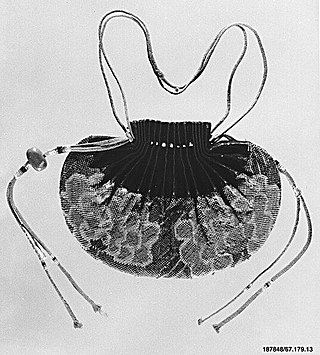
Hebao, sometimes referred as Propitious pouch in English, is a generic term used to refer to Chinese embroidery pouches, purses, or small bags. When they are used as Chinese perfume pouch, they are referred as xiangnang, xiangbao, or xiangdai. In everyday life, hebao are used to store items. In present-days China, xiangbao are still valued traditional gifts or token of fortune. Xiangbao are also used in Traditional Chinese medicine.


















